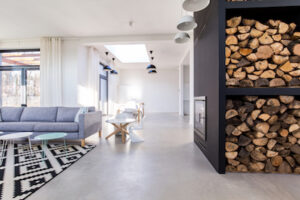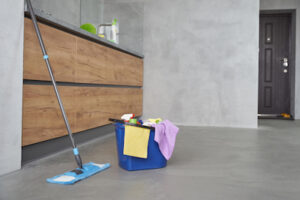The Best Practices for Maintaining Honed and Polished Concrete Floors
When it comes to modern interior design, concrete floors have become an increasingly popular choice. Their sleek and industrial appeal adds a unique touch to any space, making them a favorite among architects, interior designers, and homeowners alike. Two of the most sought-after finishes for concrete floors are honed and polished concrete. While they may seem similar at first glance, there are significant differences between honed and polished concrete that impact their appearance and maintenance requirements. In this blog, we’ll delve into the difference between honed and polished concrete and explore the best practices for maintaining their beauty and longevity.
Honed and polished concrete are both popular finishes for concrete surfaces, but they differ significantly in appearance and characteristics. Honed concrete undergoes a grinding process to achieve a smooth and consistent surface with a matte-like finish. This coating offers a low-gloss appearance while preserving the concrete’s inherent texture. The process of polishing concrete, on the other hand, is a more time-consuming grinding procedure that makes use of finer abrasives to produce a glossy, mirror-like surface. Compared to honed concrete, polished concrete is more elegant-looking and highly reflecting. Additionally, polished concrete tends to be more durable and stain-resistant due to the densification process involved. The choice between honed and polished concrete depends on the desired aesthetic and practical considerations of the specific project.

The Importance of Proper Maintenance
No matter if you select polished or honed concrete floors, regular maintenance is necessary to keep them looking good and lasting a long time. These exquisite floors not only add a touch of sophistication to your living space but also require consistent care to retain their shine and flawless appearance. By following a routine cleaning regimen, promptly addressing spills and stains, and utilizing protective measures, you ensure that your investment in these floors continues to enhance the aesthetic value of your home for years to come.
How to Maintain Honed and Polished Concrete Floors (Home DIY Guide)
Let’s explore some best practices for maintaining honed and polished concrete floors in your home.
1. Regular Cleaning
Regular cleaning is essential to maintain the appearance and longevity of both honed and polished concrete floors. To prevent surface scratches, daily cleaning with a soft-bristled broom or microfiber dust mop is recommended to remove dust and debris. Harsh cleaning tools should be avoided as they can damage the surface. For deeper cleaning, opt for a pH-neutral cleaner mixed with water to ensure the sealer’s integrity remains intact while steering clear of harsh chemicals or acidic solutions that could potentially harm the floor’s finish and compromise its overall durability.
2. Handling Stains (Prompt Spill Cleanup)
Accidents happen, and when spills occur on concrete floors, it’s essential to clean them up promptly. Wipe away spills with a soft cloth or paper towel and rinse the area with water and mild soap. Avoid using vinegar or ammonia-based cleaners, as they can break down the sealer and stain the surface. Remember to rinse the area thoroughly after cleaning.
3. Sealing Maintenance
Both honed and polished concrete floors benefit from a high-quality sealer that protects the surface from stains and moisture penetration. The frequency of resealing depends on the level of foot traffic and wear-the-floor experiences. As a general guideline, reseal honed concrete floors every 1 to 3 years, and polished concrete floors every 2 to 5 years. However, it’s best to consult with a professional concrete flooring expert to determine the most suitable resealing schedule for your specific environment.
4. Avoiding Heavy Impact and Using Protective Measures (Mats and Furniture Pads)
While concrete floors are known for their durability, they are not entirely impervious to damage. Prevention is key to maintaining the beauty and integrity of the floor. So, avoid dropping heavy objects, dragging furniture without protection, or using sharp objects that may scratch the surface. Place doormats at entryways to trap dirt and prevent it from being tracked onto the floor. Additionally, use furniture pads under the legs of chairs, tables, and other furniture to prevent scratches and scuffs.
5. Regular Maintenance Inspections
Schedule regular maintenance inspections with a professional concrete flooring contractor to assess the condition of your floors. A qualified expert can identify minor issues before they escalate into major problems, saving you time and money in the long run.
6. Polishing
Depending on foot traffic, consider periodic polishing to maintain the floor’s luster. For regular polishing, use a polishing compound and a buffing machine for best results.
7. Rejuvenation and Repolishing
Over time, even with the best maintenance practices, concrete floors can lose their luster due to wear and tear. When this happens, consider rejuvenating the floor through repolishing. The repolishing process involves reapplying the diamond abrasive pads to restore the glossy finish. This process can significantly extend the life of your concrete floors and bring back their original beauty.
By following these best practices, you can ensure that your honed and polished concrete floors remain a stunning centerpiece in your interior design for years to come. Whether you opt for the understated elegance of honed concrete or the striking allure of polished concrete, proper maintenance will be the key to enjoying their beauty and durability.

FAQs (Frequently Asked Questions)
How often should I clean my honed and polished concrete floors?
Regular cleaning is essential. Sweep or dust mop daily, and damp mop as needed to maintain their shine and cleanliness.
Can I use vinegar to clean my polished concrete floors?
It’s best to avoid using vinegar or acidic cleaners, as they can damage the surface’s finish. Stick to pH-neutral cleaners recommended by professionals.
Should I reapply the concrete sealer regularly?
The frequency of resealing depends on foot traffic. Generally, it’s recommended to reseal every 2-3 years to maintain protection and shine.
Can I use rugs with rubber backings on my concrete floors?
Rubber-backed rugs can sometimes trap moisture and discolor the floor. Opt for rugs with non-staining backings to prevent any potential damage.
How do I remove stubborn stains from my polished concrete floor?
For stubborn stains, create a paste using baking soda and water. Gently rub the paste onto the stain, then rinse with clean water. Note that while DIY methods can be effective for minor stains, it’s advisable to consult a professional for tougher stains to avoid causing further damage.
Is professional refinishing necessary, or can I do it myself?
Professional refinishing is recommended for optimal results. DIY refinishing can risk damaging the surface if not done correctly.
Can I use a steam mop on polished concrete floors?
It’s best to avoid steam mops, as the heat and moisture can potentially compromise the integrity of the sealer and damage the floor over time.
Final Thoughts
Honed and polished concrete floors offer distinct visual appeals that cater to different home design preferences. The maintenance practices for each finish may vary, but the underlying principles of regular cleaning, prompt spill cleanup, proper sealing maintenance, and cautious use apply to both. With proper care and attention, your concrete floors will continue to enhance the aesthetics and functionality of your space for many years to come.
